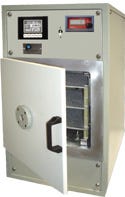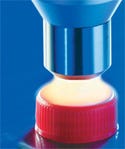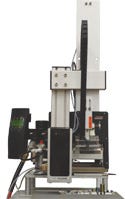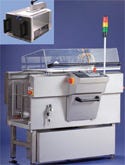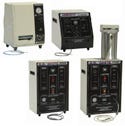Wireless data collected directly from patients during normal physical activities could enable the development of better knee implants
November 6, 2008
Originally Published MPMN November/December 2008
SPOTLIGHT
Surface Treatment, Printing, and Labeling
Etching system
|
A provider of contract plasma services and plasma equipment has released an updated version of its etching system. Designed specifically for medical device bonding applications, the PE-100 etching system modifies the surface of plastics and other materials to enhance bond strength when using adhesives. Because it operates using a dry radio frequency–induced ionization plasma process, the system does not require wet etching chemicals, which can cause contamination.
Plasma Etch Inc., Carson City, NV
www.plasmaetch.com
Atmospheric-pressure plasma process
|
An atmospheric-pressure pretreatment process activates a surface by selective oxidation, eliminates static charge, and enables microfine cleaning without the use of chemicals. Suited for medical packaging, printing, and labeling operations, the Openair plasma method promotes adhesion of printing inks, paints, and adhesives to the pretreated surface. The environmentally friendly process can be used on a variety of materials, including plastic, metal, glass, and ceramics.
Plasmatreat North America Inc., Mississauga, ON, Canada
www.plasmatreat.com
Label printer
|
Capable of printing and applying labels with or without a computer attached, a label printer and applicator can apply labels as small as 0.20 × 0.20 in. Depending on variables such as the printer used, label size, and medical product height, the PA2000 specialty tamp label printer and applicator can apply up to 58 labels per minute. In addition to an all-metal construction, the unit features a compact footprint of 30 × 15 × 32 in. and a remote front panel for easy access. The automatic or semiautomatic system can be used with the manufacturer’s H-400 series of thermal/thermal-transfer bar code label printers.
Tharo Systems Inc., Brunswick, OH
www.tharo.com
Fiber laser coders
|
Designed for use on metal, plastic, and hard-to-mark materials, two fiber laser coders can be used for such applications as direct parts marking and unique identification coding. The 10-W Model 7210 and 20-W Model 7310 fiber laser marking systems feature coding speeds of up to 350 and 700 characters per second, respectively. Both lasers use an air-cooled optical fiber as the laser medium rather than gas—as is the case with CO2 laser coders—and can apply data such as identification matrix codes, bar codes, logos, and serials on static or moving products, including medical devices. The systems feature a small marking head and a straight-out or 90° beam option and are available with standard or high-resolution marking heads.
Videojet Technologies Inc., Wood Dale, IL
www.videojet.com
Bag printing systems
|
Eliminating the need for purchasing preprinted bags or affixing labels to bags, an off-line bag printing system for medical devices achieves a print area of up to 8.4 × 19.68 in. Able to handle Tyvek, laminated foils, and plastic bags, the NGT large-format thermal transfer coder can print bar codes, logos, dates, times, and batch information directly onto bags. When combined with a Bomers Technology bag feeding system, the integrated system enables operators to load 1500 bags at once and then leave the unit unattended. It can automatically feed and print up to 1250 bags per hour.
Norwood Marking Systems, Downers Grove, IL
www.itwnorwood.com
Microabrasive blasting systems
|
Suitable for use on plastics, metals, and ceramics, a company’s microabrasive blasting machines enable users to selectively remove material from a surface without affecting the shape or form of the device. High-pressure air and fine abrasive power are combined to form an abrasive mixture that is blasted onto a surface using a small, precisely machined nozzle. The resulting abrasive stream can be applied to all types of surfaces for cleaning, deburring, cutting, drilling, and finishing operations in medical device applications.
Airbrasive, a div. of S. S. White Technologies, Piscataway, NJ
www.airbrasive.com
Copyright ©2008 Medical Product Manufacturing News
You May Also Like
